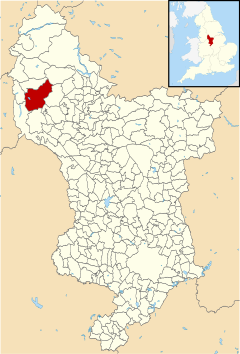Chapel en le Frith
| Chapel-en-le-Frith | |
|---|---|
 View of the town from Cowlow Lane |
|
 Chapel-en-le-Frith parish highlighted within Derbyshire |
|
| Population | 8,635 (Parish, 2011) |
| OS grid reference | SK055806 |
| Civil parish |
|
| District | |
| Shire county | |
| Region | |
| Country | England |
| Sovereign state | United Kingdom |
| Post town | HIGH PEAK |
| Postcode district | SK23 |
| Dialling code | 01298 |
| Police | Derbyshire |
| Fire | Derbyshire |
| Ambulance | East Midlands |
| EU Parliament | East Midlands |
| UK Parliament | |
Chapel-en-le-Frith /ˌtʃæpəl ˌɒn lə ˈfrɪθ/ is a small town and civil parish in Derbyshire, England. Dubbed the "Capital of the Peak"(see Chapel-en-le-Frith Rural District Council). Parts of the parish lie within the Peak District National Park, though the town itself is outside the Park boundary. The settlement was established by the Normans in the 12th century, originally as a hunting lodge within the Forest of High Peak. This led to the French-derived name of Chapel-en-le-Frith ("Chapel in the forest"). The population of 'Chapel', as locals commonly refer to it, was 8,635 in the 2011 census. For some years Chapel was the location of the High Peak Borough Council offices. The settlement has several public houses, hotels and guesthouses, a tearoom, a golf club, a cricket club and a football club.
The first chapel in the town (now the Church of St. Thomas Becket) was originally built by the Normans but was replaced with a larger building a hundred years later. It stands at the highest point in the town proper. The current building is now almost entirely of 18th-century construction above a crypt of 1225 AD. Buried in the churchyard are soldiers of the Scottish army of the Duke of Hamilton who marched south in support of Charles I in 1648. After their defeat at Preston, they were marched to Chapel and imprisoned in the church for sixteen days in such squalid conditions that forty died; a further ten died when they were marched towards Cheshire. The Eccles Pike Cross stands in the churchyard, having been moved here from Ollerenshaw Farm in 1925. It is believed to be Anglo-Saxon and is covered in very worn carvings.
...
Wikipedia
